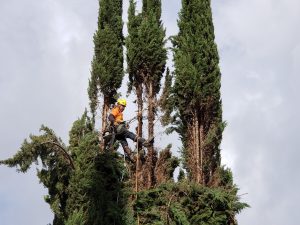Bradford pear trees are a favorite choice for many homeowners because of their gorgeous spring flowers and colorful foliage. However, to maintain the health and beauty of these stunning trees, regular maintenance—including pruning—is necessary. We’ll dive into the specifics of trim a Bradford pear tree in this tutorial, providing helpful tips and detailed directions for a fruitful pruning procedure.
Knowing Your Bradford Pear Tree
Let’s take a time to learn about the Bradford pear tree before we start the trimming process. These deciduous trees, whose scientific name is Pyrus calleryana, are well-known for their shiny green foliage and pyramidal form.
Bradford pear trees require frequent trimming since, despite their aesthetic appeal, they might have certain problems.
Why Should You Trimming a Bradford Pear Tree?
Bradford pear trees benefit from pruning for several reasons. It encourages healthy growth, helps them keep their form, and wards off possible dangers. During storms, overgrown branches can be dangerous. Strategic pruning guarantees a balanced canopy, which lowers the risk of limb breaking.
Ideal Time for Trimming Bradford Pear Tree
Pruning any tree requires careful planning, and Bradford pears are no exception. Before new growth starts, late winter or early spring is the best time to prune these trees. This guarantees that the tree will have enough time to mend and recuperate, preparing it for a trimming.
Steps to Trim a Bradford Pear Tree
Assemble Your Equipment
Make sure you have the appropriate equipment for the task before you begin cutting. It’s imperative to have a pruning saw for larger limbs, loppers for thicker branches, and a set of sharp pruning shears. To stop the transmission of illness, make sure that all of your instruments are clean and well-maintained.
Examine Your Tree
Examine your Bradford pear tree attentively first. Determine whether branches are unhealthy or dead and need to be removed. Their absence of leaves, discolouration, or indications of insect infestation help identify them. Eliminating these branches will benefit the tree’s general health in addition to its look.
Construct the Canopy
Maintaining a balanced and visually acceptable shape requires careful contouring of the canopy. Branches that are rubbing up against one another or crossing should be cut off. As a result, the canopy opens up, improving airflow and sunshine penetration.
Crown Thinning
In order to decrease density, the crown must be thinned by eliminating certain branches. By encouraging improved air circulation, this technique lowers the risk of illness and improves light penetration. To prevent overtaxing the tree, never remove more than 25% of its canopy at once.
Trimming Overgrown Branches
It’s imperative to take care of overgrown limbs on your Bradford pear tree, particularly if they have weak crotches.
These branches have a tendency to break off during storms, endangering both your tree and your belongings. Make neat, angled cuts with a pruning saw immediately outside the branch collar.
Tidying and Elimination
After you’ve finished cutting, it’s time to tidy up the leftovers. Make sure to properly dispose of the chopped branches by using a local garbage disposal agency or turning them into mulch. Cleaning up makes your garden seem neater and helps stop the spread of illness.
Advice for Trimming a Bradford Pear Trees Successfully
Steer clear of topping:
Bradford pear trees suffer from topping, or the careless removal of huge limbs. It damages the tree’s natural form and weakens it, leaving it more vulnerable to pests and illnesses.
Remember the three D’s:
Give priority to branches that show signs of disease, damage, or death when choosing which ones to cut off. By using a targeted strategy, you may be confident that the branches you remove will have the greatest detrimental effect on the health of the tree.
Clean Your Instruments:
To stop the transmission of illness, sterilize your pruning equipment in between cuts or between trees. To effectively clean your instruments, mix one part bleach to nine parts water in a basic solution.
Keep in Mind the Lower Branches:
Don’t overlook the lower branches even if the upper canopy receives a lot of attention. By trimming these branches, you may improve airflow and give lawnmowers and pedestrians more room.
FAQs
What time of year is ideal to prune my Bradford pear tree?
Before new growth appears, late winter or early spring is the best time to prune Bradford pear trees. By doing this, you may make sure the tree gets enough time to mend and get ready for a healthy new leaf growth in the approaching
How much canopy can I cut back on without endangering the tree?
Removing more than 25% of the tree’s canopy at once is not advised. A tree may get stressed and lose general health if it is overpruned. To keep a shape that is natural and balanced, concentrate on judicious cutting.
Is it possible to prune my Bradford pear tree in a different season?
Although the best times are in late winter or early spring, modest pruning can be done any time during the growing season. To save the tree from stress during the sweltering summer months, avoid severe trimming.
Is sterilizing pruning tools necessary, and if so, how should I go about doing it?
It is true that sterilizing pruning equipment is essential to stopping the spread of illness.To clean your equipment in between cuts or while transferring from one tree to another, use a solution of one part bleach to nine parts water.
Are there any particular indicators that my Bradford pear tree needs to be pruned?
The main signs of pruning are sick, damaged, or dead branches. Furthermore, take care of weak crotched limbs that are overgrown, as they might split during storms and endanger the health of the tree.
Conclusion
Although trim a Bradford pear tree may appear difficult at first, with the correct information and methods, it can be a worthwhile project. Your Bradford pear tree’s long-term health and vitality will be enhanced if you adhere to these detailed instructions and make use of the offered advice. Recall that keeping your trees well-trimmed not only improves the look of your landscape but also protects your property. Happy cutting!





